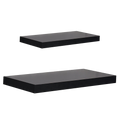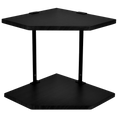- No products in the cart.



More information on Hickory:

Its name is an English contraction of the Native American "powcohicora" In Eastern North America, it survived the catastrophic changes of the Glacial Epoch, some 50 million years ago. Thus, it is the first strictly American hardwood species. Westward trekking pioneers made hickory a prerequisite for their wagon wheels. Later, the Wright Brothers whittled hickory for their "flying contraption." Hickory sawdust and chips are used to flavor meat by smoking. Commercially, the pecan is the most important native North American nut tree and it is the state tree of Texas. Pecan was a Native American name given to any nut hard enough to require cracking with a stone. Native Americans, particularly in the Northeast, used hickory for their bows.
Where it Grows
Eastern U.S., principal commercial areas: Central and Southern states. Tree height ranges from 60 to 120 feet. Hickories grow slowly and it is not unusual for a tree to take 200 years to mature.
Main Uses
Tool handles, furniture, cabinetry, flooring, paneling, wooden ladders, dowels, and sporting goods.
General Description
The hickories are an important group within the Eastern hardwood forests. Botanically they are split into two groups; the true hickories, and the pecan hickories (fruit-bearing). The wood is virtually the same for both and is usually sold together. Hickory is the hardest, heaviest and strongest American wood. The sapwood of hickory is white, tinged with inconspicuous fine brown lines while the heartwood is pale to reddish brown. Both are coarse-textured and the grain is fine, usually straight but can be wavy or irregular.
Working Properties
The heaviest of American hardwoods, the hickories can be difficult to machine and glue and are very hard to work with hand tools, so care is needed. They hold nails and screws well, but there is a tendency to split so pre-boring is advised. The wood can be sanded to a good finish. The grain pattern welcomes a full range of medium-to-dark finishes and bleaching treatments. It can be difficult to dry and has high shrinkage.
Physical Properties
The density and strength of the hickories will vary according to the rate of growth, with the true hickories generally showing higher values than the pecan hickories. The wood is well-known for its very good strength and shock resistance and it also has excellent steam-bending properties. Extremely tough and resilient, even texture, quite hard and only moderately heavy.
Physical Properties
The wood is of medium density with good bending properties, it has low stiffness and medium strength and shock resistance.
You may also be interested in following Floor Registers:
Red Oak Floor Registers White Oak Floor Registers
American Cherry Floor Registers Maple Floor Registers
American Walnut Floor Registers Brazilian Cherry Foor Registers
Brazilian Walnut Floor Registers Santos Mahogany Floor Registers
More information on Hickory:

Its name is an English contraction of the Native American "powcohicora" In Eastern North America, it survived the catastrophic changes of the Glacial Epoch, some 50 million years ago. Thus, it is the first strictly American hardwood species. Westward trekking pioneers made hickory a prerequisite for their wagon wheels. Later, the Wright Brothers whittled hickory for their "flying contraption." Hickory sawdust and chips are used to flavor meat by smoking. Commercially, the pecan is the most important native North American nut tree and it is the state tree of Texas. Pecan was a Native American name given to any nut hard enough to require cracking with a stone. Native Americans, particularly in the Northeast, used hickory for their bows.
Where it Grows
Eastern U.S., principal commercial areas: Central and Southern states. Tree height ranges from 60 to 120 feet. Hickories grow slowly and it is not unusual for a tree to take 200 years to mature.
Main Uses
Tool handles, furniture, cabinetry, flooring, paneling, wooden ladders, dowels, and sporting goods.
General Description
The hickories are an important group within the Eastern hardwood forests. Botanically they are split into two groups; the true hickories, and the pecan hickories (fruit-bearing). The wood is virtually the same for both and is usually sold together. Hickory is the hardest, heaviest and strongest American wood. The sapwood of hickory is white, tinged with inconspicuous fine brown lines while the heartwood is pale to reddish brown. Both are coarse-textured and the grain is fine, usually straight but can be wavy or irregular.
Working Properties
The heaviest of American hardwoods, the hickories can be difficult to machine and glue and are very hard to work with hand tools, so care is needed. They hold nails and screws well, but there is a tendency to split so pre-boring is advised. The wood can be sanded to a good finish. The grain pattern welcomes a full range of medium-to-dark finishes and bleaching treatments. It can be difficult to dry and has high shrinkage.
Physical Properties
The density and strength of the hickories will vary according to the rate of growth, with the true hickories generally showing higher values than the pecan hickories. The wood is well-known for its very good strength and shock resistance and it also has excellent steam-bending properties. Extremely tough and resilient, even texture, quite hard and only moderately heavy.
Physical Properties
The wood is of medium density with good bending properties, it has low stiffness and medium strength and shock resistance.
You may also be interested in following Floor Registers:
Red Oak Floor Registers White Oak Floor Registers
American Cherry Floor Registers Maple Floor Registers
American Walnut Floor Registers Brazilian Cherry Foor Registers
Brazilian Walnut Floor Registers Santos Mahogany Floor Registers